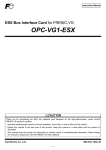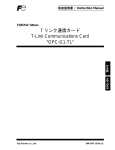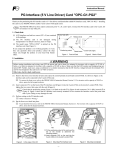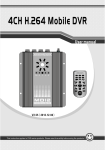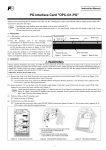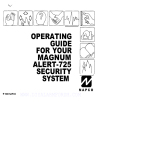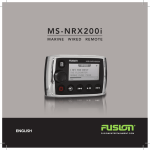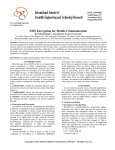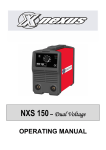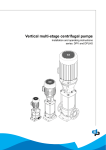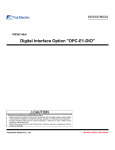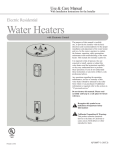Download "OPC-G1-DI" "OPC-G1-DO"
Transcript
/ Instruction Manual Digital Input Interface Card "OPC-G1-DI" Digital Output Interface Card "OPC-G1-DO" Fuji Electric Co., Ltd. INR-SI47-1249c-JE English Version Preface Thank you for purchasing our digital interface card(s). This instruction manual describes the digital input interface card "OPC-G1-DI" and the digital output interface card "OPC-G1-DO" designed for the FRENIC-MEGA series of inverters. For descriptions of the former, refer to Chapter 2 "DIGITAL INPUT INTERFACE CARD"; for the latter, refer to Chapter 3 "DIGITAL OUTPUT INTERFACE CARD." Chapters 1, 4, and 5 are common to both cards. Mounting the digital input interface card on your FRENIC-MEGA makes it possible to specify frequency commands with binary code (8, 12, 15, or 16 bits) or BCD (4-bit Binary Coded Decimal) code. Mounting the digital output interface card on your FRENIC-MEGA enables monitoring with 8-bit binary code. Each of the digital input interface card and the digital output interface card can be connected to any one of the three option connection ports (A-, B-, and C-ports) on the FRENIC-MEGA. Concurrent use of both cards provides a digital input/output interface. This instruction manual does not contain inverter handling instructions. Read through this instruction manual in conjunction with the FRENIC-MEGA Instruction Manual and be familiar with proper handling and operation of this product. Improper handling might result in incorrect operation, a short life, or even a failure of this product. Keep this manual in a safe place. • Read through this instruction manual and be familiar with the digital interface card(s) before proceeding with installation, connections (wiring), operation, or maintenance and inspection. • Improper handling might result in incorrect operation, a short life, or even a failure of this product as well as the motor. • Deliver this manual to the end user of this product. Keep this manual in a safe place until this product is discarded. Safety precautions Read this manual thoroughly before proceeding with installation, connections (wiring), operation, or maintenance and inspection. Ensure you have sound knowledge of the device and familiarize yourself with all safety information and precautions before proceeding to operate the inverter. Safety precautions are classified into the following two categories in this manual. Failure to heed the information indicated by this symbol may lead to dangerous conditions, possibly resulting in death or serious bodily injuries. Failure to heed the information indicated by this symbol may lead to dangerous conditions, possibly resulting in minor or light bodily injuries and/or substantial property damage. Failure to heed the information contained under the CAUTION title can also result in serious consequences. These safety precautions are of utmost importance and must be observed at all times. Installation and wiring • Before starting installation and wiring, turn OFF the power and wait at least five minutes for inverters with a capacity of 22 kW or below, or at least ten minutes for inverters with a capacity of 30 kW or above. Make sure that the LED monitor and charging lamp are turned OFF. Further, make sure, using a multimeter or a similar instrument, that the DC link bus voltage between the terminals P(+) and N(-) has dropped to the safe level (+25 VDC or below). • Qualified electricians should carry out wiring. Otherwise, an electric shock could occur. • Do not use the product that is damaged or lacking parts. Doing so could cause a fire, an accident, or injuries. • Prevent lint, paper fibers, sawdust, dust, metallic chips, or other foreign materials from getting into the inverter and the option. Otherwise, a fire or an accident might result. • Incorrect handling in installation/removal jobs could cause a failure. A failure might result. • Noise may be emitted from the inverter, motor and wires. Implement appropriate measure to prevent the nearby sensors and devices from malfunctioning due to such noise. Otherwise, an accident could occur. Operation • Be sure to install the front cover before turning the inverter's power ON. Do not remove the cover when the inverter power is ON. Otherwise, an electric shock could occur. • Do not operate switches with wet hands. Doing so could cause an electric shock. • If you configure the function codes wrongly or without completely understanding FRENIC-MEGA Instruction Manual and the FRENIC-MEGA User's Manual, the motor may rotate with a torque or at a speed not permitted for the machine. Confirm and adjust the setting of the function codes before running the inverter. Otherwise, an accident could occur. Maintenance and inspection, and parts replacement • Before proceeding to the maintenance/inspection jobs, turn OFF the power and wait at least five minutes for inverters with a capacity of 22 kW or below, or at least ten minutes for inverters with a capacity of 30 kW or above. Make sure that the LED monitor and charging lamp are turned OFF. Further, make sure, using a multimeter or a similar instrument, that the DC link bus voltage between the terminals P(+) and N(-) has dropped to the safe level (+25 VDC or below). Otherwise, an electric shock could occur. • Maintenance, inspection, and parts replacement should be made only by qualified persons. • Take off the watch, rings and other metallic objects before starting work. • Use insulated tools. Otherwise, an electric shock or injuries could occur. Disposal • Treat the interface card(s) as an industrial waste when disposing of it. Otherwise injuries could occur. Others • Never modify the interface card(s). Doing so could cause an electric shock or injuries. Icons The following icons are used throughout this manual. This icon indicates information which, if not heeded, can result in the product not operating to full efficiency, as well as information concerning incorrect operations and settings which can result in accidents. This icon indicates information that can prove handy when performing certain settings or operations. This icon indicates a reference to more detailed information. Table of Contents Preface ............................................................................... i Safety precautions ............................................................. i Chapter 1 BEFORE USING THIS OPTION .....................1-1 1.1 Acceptance Inspection ...........................................1-1 1.2 Applicable Inverters ................................................1-2 1.3 Operating Environment ..........................................1-2 1.4 Installation and Removal of the Interface Card.......1-2 1.4.1 Installing the interface card ............................1-3 1.4.2 Removing the interface card ..........................1-4 1.5 Wiring .....................................................................1-5 Chapter 2 DIGITAL INPUT INTERFACE CARD...............2-1 2.1 Terminal Allocation and Symbol Diagram .................2-1 2.2 Connection Diagram .................................................2-1 2.3 Terminal Functions .................................................2-2 2.4 Electrical Specifications ..........................................2-2 2.5 Input Interface ........................................................2-3 2.5.1 Switching between SINK and SOURCE for digital input terminals ([I1] to [I16]) ...........2-3 2.5.2 Connection diagrams for SINK/SOURCE input modes ...................................................2-3 2.5.3 Precaution on the use of a contact relay ........2-3 2.6 Configuring Inverter's Function Codes ...................2-4 2.7 Details of Function Codes ......................................2-5 Chapter 3 DIGITAL OUTPUT INTERFACE CARD...........3-1 3.1 Terminal Allocation and Symbol Diagram ...............3-1 3.2 Connection Diagram ...............................................3-1 3.3 Terminal Functions .................................................3-2 3.4 Electrical Specifications ..........................................3-2 3.5 Output Interface......................................................3-2 3.6 Configuring Inverter's Function Code .....................3-3 3.7 Details of Function Code ........................................3-4 Chapter 4 I/O CHECKING ...............................................4-1 Chapter 5 PROTECTIVE FUNCTION .............................5-1 Chapter 1 BEFORE USING THIS OPTION 1.1 Acceptance Inspection Unpack the package and check the following: (1) An interface card, two screws (M3 8), and the Digital Input Interface Card/Digital Output Interface Card Instruction Manual (this manual) are contained in the package. (2) The interface card is not damaged during transportation--no defective parts, dents or warps. (3) The following model name is printed on the interface card. • Digital input interface card: "OPC-G1-DI" (See Figure 1.1.) • Digital output interface card: "OPC-G1-DO" (See Figure 1.2.) If you suspect the product is not working properly or if you have any questions about your product, contact the shop where you bought the product or your local Fuji branch office. Screw hole (left) Model name Release knob SW1 CN1 (Front) Positioning cutout (Back) Screw hole (right) Figure 1.1 Name of Parts on Digital Input Interface Card (OPC-G1-DI) Screw hole (left) Model name Release knob CN1 (Front) Positioning cutout (Back) Screw hole (right) Figure 1.2 Name of Parts on Digital Output Interface Card (OPC-G1-DO) 1-1 1.2 Applicable Inverters This interface card is applicable to the following inverters and ROM version. Table 1.1 Applicable inverter and ROM version Series Inverter type FRENIC-MEGA * The boxes FRN G1 - Applicable motor rating ROM version All capacities 0500 or later replace alphabetic letters depending on the nominal applied motor, enclosure, and power supply voltage. To check the inverter's ROM version, use Menu #5 "Maintenance Information" on the keypad. (Refer to the FRENIC-MEGA Instruction Manual, Chapter 3, Section 3.4.6 "Reading maintenance information." Display on LED Monitor Item Inverter's ROM version Description Shows the inverter's ROM version as a 4-digit code. 1.3 Operating Environment Install the inverter equipped with this interface card in an environment that satisfies the requirements listed in Table 1.2. Table 1.2 Environmental Requirements Item Specifications Site location Indoors Surrounding temperature Refer to the FRENIC-MEGA Instruction Manual, Chapter 2. Relative humidity 5 to 95% (No condensation) Atmosphere The inverter must not be exposed to dust, direct sunlight, corrosive gases, flammable gases, oil mist, vapor or water drops. Pollution degree 2 (IEC60664-1) (Note) The atmosphere can contain a small amount of salt. (0.01 mg/cm2 or less per year) The inverter must not be subjected to sudden changes in temperature that will cause condensation to form. Altitude 1,000 m max. Atmospheric pressure 86 to 106 kPa Vibration Refer to the FRENIC-MEGA Instruction Manual, Chapter 2. (Note) Do not install the inverter in an environment where it may be exposed to lint, cotton waste or moist dust or dirt which will clog the heat sink of the inverter. If the inverter is to be used in such an environment, install it in a dustproof panel of your system. 1.4 Installation and Removal of the Interface Card Before starting installation and wiring, turn OFF the power and wait at least five minutes for inverters with a capacity of 22 kW or below, or at least ten minutes for inverters with a capacity of 30 kW or above. Make sure that the LED monitor and charging lamp are turned OFF. Further, make sure, using a multimeter or a similar instrument, that the DC link bus voltage between the terminals P(+) and N(-) has dropped to the safe level (+25 VDC or below). Otherwise, an electric shock could occur. 1-2 • Do not use the product that is damaged or lacking parts. Doing so could cause a fire, an accident, or injuries. • Prevent lint, paper fibers, sawdust, dust, metallic chips, or other foreign materials from getting into the inverter and the interface card. Otherwise, a fire or an accident might result. • Incorrect handling in installation/removal jobs could cause a failure. A failure might result. 1.4.1 Installing the interface card Before mounting the interface card, perform the wiring for the main circuit terminals and control circuit terminals. (1) Remove the front cover from the inverter and expose the control printed circuit board (control PCB). As shown in Figure 1.3, the interface card can be connected to any one of the three option connection ports (A-, B-, and C-ports) of the inverter. To remove the front cover, refer to the FRENIC-MEGA Instruction Manual, Section 2.3. For inverters with a capacity of 30 kW or above, open also the keypad enclosure. (2) Insert connector CN1 on the back of the interface card (Figure 1.1 or 1.2) into any of the A-port (CN4), B-port (CN5), and C-port (CN6) on the inverter's control PCB. Then tighten the two screws that come with the card. (Figure 1.5) Check that the positioning cutout (shown in Figures 1.1 and 1.2) is fitted on the tab ( in Figure 1.4) and connector CN1 is fully inserted ( in Figure 1.4). Figure 1.5 shows the interface card correctly mounted. (3) Perform wiring on the interface card. Refer to Section 1.5 "Wiring." (4) Put the front cover back into place. To put back the front cover, refer to the FRENIC-MEGA Instruction Manual, Section 2.3. For inverters with a capacity of 30 kW or above, close also the keypad enclosure. Figure 1.3 In the case of 0.4 kW 1-3 Fit the positioning cutout of the card over the tab on the inverter to determine the mounting position. Insert connector CN1 on the card into any of the three ports (A-, B- and C-ports) on the inverter's control PCB. Note: Be sure to follow the order of and . Inserting CN1 first may lead to insufficient insertion, resulting in a contact failure. Tab Figure 1.4 Mounting the Interface Card (to B-port) (Release knob) Figure 1.5 Mounting Completed (to B-port) 1.4.2 Removing the interface card Remove the two screws that secure the interface card and pull the release knob (shown above) to take the card out of the inverter. 1-4 1.5 Wiring • Before starting installation and wiring, turn OFF the power and wait at least five minutes for inverters with a capacity of 22 kW or below, or at least ten minutes for inverters with a capacity of 30 kW or above. Make sure that the LED monitor and charging lamp are turned OFF. Further, make sure, using a multimeter or a similar instrument, that the DC link bus voltage between the terminals P(+) and N(-) has dropped to the safe level (+25 VDC or below). • Qualified electricians should carry out wiring. Otherwise, an electric shock could occur. • In general, the covers of the control signal wires are not specifically designed to withstand a high voltage (i.e., reinforced insulation is not applied). Therefore, if a control signal wire comes into direct contact with a live conductor of the main circuit, the insulation of the cover might break down, which would expose the signal wire to a high voltage of the main circuit. Make sure that the control signal wires will not come into contact with live conductors of the main circuit. Failure to observe this precaution could cause an electric shock or an accident. Noise may be emitted from the inverter, motor and wires. Take appropriate measures to prevent the nearby sensors and devices from malfunctioning due to such noise. An accident could occur. Perform wiring for the interface card observing the precautions below. Refer to the connection diagrams shown in Figure 2.2 (Chapter 2) and Figure 3.2 (Chapter 3), and the wiring examples shown in Figure 1.8. (1) Turn the inverter's power OFF. (2) Use shielded wires. (3) To prevent malfunction due to noise, keep the wiring for the interface card away from the main circuit wiring and other power lines as far as possible. Never install them in the same wire duct. (4) Complete wiring before turning the inverter ON. (5) See Table 1.3 for the specifications of the terminal block on the interface card. When using stripped wires (without attaching a crimp terminal), strip the wire end by 5 to 7 mm. (Figure 1.6) When using a crimp terminal, attach a vinyl-insulated ferrule. Loosen the terminal screw, insert the wire end into above the metal part of the terminal block, and tighten the screw to fasten it. (Figure 1.7) Table 1.3 Terminal Specifications Item Specifications Wire size AWG24 to AWG18 (0.25 to 0.75 mm2 ), wire with rated temperature 105°C (UL) recommended Terminal screw size M2 Tightening torque 0.22 to 0.25 N·m 5 to 7 mm Figure 1.6 Wire End Treatment (For Connection to Terminals on Interface Card) Figure 1.7 Connecting to a Terminal on Interface Card • Route the wiring of the interface circuit terminals as far from the wiring of the main circuit as possible. Otherwise electric noise may cause malfunctions. • Fix the interface circuit wires with a cable tie inside the inverter to keep them away from the live parts of the main circuit (such as the terminal block of the main circuit). 1-5 Depending upon the wire type and the number of wires used, the front cover may be lifted by the wires, which impedes normal keypad operation. If it happens, change the wire type or size. Route the wires, taking care not to let them go over the control PCB, as shown in Figure 1.8. Otherwise, malfunctions may occur. • For inverters with a capacity of 22 kW or below When grounding the shielded cable, use a crimp ring terminal with insulation sheath, R1.25-3 or the like and fasten it together with the card using this screw. * Pass the wires from the interface card between the control circuit terminal block and the front cover. In the case of 0.4 kW • For inverters with a capacity of 30 kW or above In the case of 75 kW Figure 1.8 Examples of Wiring 1-6 Chapter 2 DIGITAL INPUT INTERFACE CARD 2.1 Terminal Allocation and Symbol Diagram I16 CM I15 I14 I12 I13 I10 I11 I8 I9 I6 I7 I4 I5 M1 I2 I3 I1 Figure 2.1 Terminal Allocation and Symbol Diagram 2.2 Connection Diagram FRENIC-MEGA L1/R U L2/S V L3/T W M1 OPC-G1-DI I16 I15 I14 I13 I12 I11 I10 I9 SW1 I8 I7 I6 I5 I4 I3 I2 I1(LSB) SINK SOURCE CM Figure 2.2 Connection Diagram 2-1 2.3 Terminal Functions Table 2.1 lists terminal symbols, names and functions of the terminals on the digital input interface card. Table 2.1 Terminals and Their Specifications Terminal symbol [I1] to [I16] Name Functions (1) These digital inputs specify a frequency command according to the settings made by function codes o19 and o20. For details, refer to Section 2.6 "Configuring Inverter's Function Codes." Digital inputs 1 to 16 (2) SINK/SOURCE is switchable with the slide switch SW1. [M1] External power supply input Power input terminal from the external device for the interface card (+22 to +27 VDC) [CM] Digital common Common terminal for digital input signals (Equipotent with [CM] terminal of the inverter) 2.4 Electrical Specifications Table 2.2 lists the electrical specifications for the digital input interface card. Table 2.2 Electrical Specifications Terminal symbol [I1] to [I16] Specifications Item Min. Max. Operating voltage (SINK) ON level 0V 2V OFF level 22 V 27 V Operating voltage (SOURCE) ON level 22 V 27 V OFF level 0V 2V 2.5 mA 5 mA - 0.5 mA Operating current at ON (Input voltage is at 0 V) Allowable leakage current at OFF 2-2 2.5 Input Interface 2.5.1 Switching between SINK and SOURCE for digital input terminals ([I1] to [I16]) The input mode is switchable between SINK and SOURCE for digital input terminals ([I1] to [I16]) by using the slide switch SW1 on the interface card (Figure 1.1 in Chapter 1). Specify the input mode referring to Table 2.3 below. Table 2.3 Configuration of Slide Switch SW1 Input mode Slide switch position SINK SW1 SINK (factory default) SINK side SOURCE SW1 SOURCE SINK SOURCE side SOURCE The inverter also has the slide switch SW1 on the control PCB to specify SINK or SOURCE for the inverter's digital input terminals. Match the setting of SW1 on the interface card with that of the inverter. 2.5.2 Connection diagrams for SINK/SOURCE input modes Table 2.4 shows connection diagrams for input interface circuits. Table 2.4 Connections of Input Interface Circuits Connection diagram Power supply SINK mode SOURCE mode P L C *1 MEGA In te rfa ce ca rd M1 M1 Inte rfa ce ca rd + 24 V +24 V Internal S IN K S IN K S O U RC E S O U RC E I1 to I1 6 I1 to I1 6 CM CM CM CM *1 The maximum allowable current for terminal [PLC] on the FRENIC-MEGA is 100 mA. Inte rface c ard In te rface ca rd M1 M1 +2 4 V SI NK External SO UR CE S O UR CE +2 4 V I1 to I16 CM +2 4 V SIN K +2 4 V I 1 to I1 6 CM CM 2.5.3 Precaution on the use of a contact relay To configure input circuits using contact relays, use highly reliable relays. 2-3 CM 2.6 Configuring Inverter's Function Codes To enable frequency command inputs from this interface card, it is required to set function code data of F01 (Frequency Command 1) or C30 (Frequency Command 2) to "11" (Digital input interface card). Also specify the polarity and input mode of the frequency command using function codes o19 (DI polarity) and o20 (DI mode) provided for options, respectively. Table 2.5 lists function codes and their parameters. The function codes o19 and o20 become available when the digital input interface card is connected to the inverter. Table 2.5 Function Codes and Parameters Drive control *4 Function code F01 C30 Name Frequency Command 1 Frequency Command 2 Data setting range 0: / keys on keypad 1: Voltage input to terminal [12] 2: Current input to terminal [C1] 3: Sum of voltage and current inputs to terminals [12] and [C1] 5: Voltage input to terminal [V2] 7: Terminal command UP/DOWN control 8: / keys on keypad (balanceless-bumpless switching available) V/f w/o PG w/ PG N Y 0 Y Y Y N Y 0 Y Y Y N Y 0 Y Y Y 11: Digital input interface card (option) 12: Pulse train input o19 o20 DI option 0: Without polarity (DI polarity) 1: With polarity *1 (DI mode) 0: 8-bit binary frequency command 1: 12-bit binary frequency command 2: 15-bit binary frequency command 3: 16-bit binary frequency command 4: 4-digit BCD frequency command (0 to 99.99 Hz) 5: 4-digit BCD frequency command (0 to 500.0 Hz) BCD: Binary Coded Decimal *1 *2 *3 *4 "Without polarity" when o20 = 4 or 5 (BCD). Y: Possible, N: Impossible Y: Possible, N: Impossible Y: Applicable, N: Not applicable For details, refer to the FRENIC-MEGA Instruction Manual. 2-4 2.7 Details of Function Codes Table 2.6 shows the configuration of function codes o19 and o20 and the details of the terminal functions. Turning the terminal input OFF or ON sets each bit data to "0" or "1," respectively. Table 2.6 Details of Function Codes No. o19 o20 Input signal name Terminal function and configuration details MSB I16 I15 I14 I13 I12 I11 I10 0 0 I9 I8 I6 I5 I4 I3 I2 I1 Frequency command Invalid 8-bit binary frequency command LSB I7 Hold signal W hen I16 is OFF (0), the interface circuit updates the frequency command according to the input data. W hen I16 is ON (1), the interface circuit discards the input data and holds the current frequency command. Setting resolution = Maximum frequency (1/255) M SB LS B I16 I1 5 I1 4 I 13 I12 I1 1 I10 0 1 I8 I7 I6 I5 I4 I3 I2 H o ld sign al W he n I1 6 is O FF (0), th e inte rface circuit up da tes th e freq uen cy com m and accordin g to the inpu t data . W he n I16 is O N (1), the interface circu it d iscard s th e inp ut data and ho lds the cu rrent fre qu ency co m m and. Setting resolution = Maximum frequency (1/4095) LS B M SB I16 I15 I 14 I 13 I12 I 11 I10 0 2 I9 I8 I7 I6 I5 I4 I3 I2 H o ld s ign a l W h en I16 is O FF (0), th e inte rface circu it up da tes the frequ ency com m an d accordin g to the inp ut data . W h en I16 is O N (1), the in terfa ce circuit discards the inp ut data a nd ho lds the current fre qu ency com m and . (1/32767) M SB 3 16-bit binary frequency command LS B I16 I15 I14 I13 I1 2 I1 1 I1 0 I9 I8 I7 I6 I5 I4 I3 I2 I3 I2 (1/65535) M SB LS B I16 I15 I14 I13 I1 2 I1 1 I1 0 0, 1 4 Te ns pla ce of H z I9 I8 I7 I6 I5 Te nth p lace of H z U nits pla ce of H z I4 H und red th p lace of H z M SB LS B H und red s place of H z 5 4-digit BCD frequency command (0 to 500.0 Hz) I1 Frequency can be specified within the range of 0 to 99.99 Hz (Setting resolution = 0.01 Hz). If a frequency command exceeding the maximum frequency is input, the maximum frequency applies. I16 I1 5 I1 4 I13 I12 I11 I10 0, 1 I1 F re qu e nc y c o m m a n d Setting resolution = Maximum frequency 4-digit BCD frequency command (0 to 99.99 Hz) I1 F re qu en c y c om m a nd 15-bit binary frequency command Setting resolution = Maximum frequency 0 I1 F re qu en c y c om m a nd In valid 12-bit binary frequency command I9 Te ns pla ce o f Hz I9 I8 I7 I6 U nits pla ce of H z I5 I4 I3 I2 I1 Te nth p lace o f Hz H o ld s ig n al W h en I16 is O F F (0 ), the inte rface circuit upd ate s th e freq uen cy co m m a nd a ccordin g to the inp ut d ata. W h en I16 is O N (1 ), the in terfa ce circuit discards the inpu t data a nd h old s th e cu rre nt fre qu enc y com m an d. Frequency can be specified within the range of 0 to 500.0 Hz. (Setting resolution = 0.1 Hz). If a frequency command exceeding the maximum frequency is input, the maximum frequency applies. 2-5 No. o19 o20 Input signal name Terminal function and configuration details M SB I16 I1 5 I1 4 I13 I 12 I11 I1 0 I9 I8 LS B I7 I6 I5 I4 I3 I2 I1 F re qu e nc y c o m m an d Inv alid H o ld sig na l 1 0 8-bit binary frequency command W h en I16 is O FF (0 ), the inte rface circuit u pd ate s the freq uen cy com m an d a ccord ing to the inp ut d ata. W h en I16 is O N (1), the in terface circuit disca rds the inp ut da ta a nd ho lds th e curren t fre qu ency com m an d. Frequency setting range: -(Maximum frequency) to +(Maximum frequency) = -128 to +127 Setting resolution = Maximum frequency x (1/127) M SB LS B I16 I1 5 I1 4 I13 I 12 I11 I1 0 I9 I8 I7 I6 I5 I4 I3 I2 I1 F re qu e n cy c o m m a nd In valid H o ld sig na l 1 1 12-bit binary frequency command W h en I16 is O FF (0 ), the inte rface circuit u pd ate s the freq uen cy com m an d a ccord in g to th e in pu t d ata. W h en I16 is O N (1), the in terface circuit disca rds the inp ut da ta a nd ho lds th e curren t fre qu ency com m an d. Frequency setting range: -(Maximum frequency) to +(Maximum frequency) = -2048 to +2047 Setting resolution = Maximum frequency (1/2047) M SB LS B I1 6 I15 I1 4 I13 I12 I11 I1 0 I9 I8 I7 I6 I5 I4 I3 I2 I1 F re qu e nc y c o m m a nd H o ld s ig n al 1 2 15-bit binary frequency command W h en I16 is O F F (0 ), the inte rface circuit u pd ate s the freq uen cy co m m an d a ccord ing to the inp ut d ata. W h en I16 is O N (1 ), the in terface circuit disca rds the inp ut data a nd h old s th e cu rren t fre qu ency com m an d. Frequency setting range: -(Maximum frequency) to +(Maximum frequency) = -16384 to +16383 Setting resolution = Maximum frequency (1/16383) M SB LS B I1 6 I15 I14 I1 3 I 12 I11 I 10 1 3 16-bit binary frequency command I9 I8 I7 I6 I5 I4 I3 F re qu e nc y c om m a nd Frequency setting range: -(Maximum frequency) to +(Maximum frequency) = -32768 to +32767 Setting resolution = Maximum frequency 2-6 (1/32767) I2 I1 Chapter 3 DIGITAL OUTPUT INTERFACE CARD 3.1 Terminal Allocation and Symbol Diagram O8 O7 O6 O5 O4 O3 O2 O1 M2 Figure 3.1 Terminal Allocation and Symbol Diagram 3.2 Connection Diagram FRENIC-MEGA L1/R U L2/S V L3/T W OPC-G1-DO Ry (MSB) O8 Ry O7 Ry O6 Ry O5 Ry O4 Ry O3 Ry O2 Ry (LSB) O1 24 VDC CM Figure 3.2 Connection Diagram 3-1 3.3 Terminal Functions Table 3.1 lists terminal symbols, names and functions of the terminals on the digital output interface card. Table 3.1 Terminals and Their Specifications Terminal symbol [O1] to [O8] Name Functions Transistor outputs 1 to 8 These digital terminals output various status (e.g., output frequency, output current) specified by function code o21 as an 8-bit parallel signal. Common terminal for transistor output signals. [M2] Transistor output common This terminal is electrically isolated from terminals [CM], [11]s, and [CMY]. 3.4 Electrical Specifications Table 3.2 lists the electrical specifications for the digital output interface card. Table 3.2 Electrical Specifications Specifications Terminal symbol Item Max. Operating voltage [O1] to [O8] ON level 2V OFF level 27 V Source current at ON 50 mA Leakage current at OFF 0.1 mA 3.5 Output Interface Table 3.3 shows connection diagrams for output interface circuits. Table 3.3 Connections of Output Interface Circuits Connection diagram Interface card M2 SINK mode O1 to O8 24 V Interface card M2 24 V SOURCE mode O1 to O8 3-2 3.6 Configuring Inverter's Function Code Function code o21 (DO mode selection) provided for options specifies the item to be monitored by digital signals of this digital output interface card. Table 3.4 lists the function code and its parameters. The function code o21 becomes available when the digital output interface card is connected to the inverter. Table 3.4 Function Code and Parameters Drive control *3 Function code o21 Name DO option (DO mode selection) Data setting range 0: Output frequency (before slip compensation) 1: Output frequency (after slip compensation) 2: Output current 3: Output voltage 4: Output torque 5: Load factor 6: Input power 7: PID feedback amount 8: PG feedback value 9: DC link bus voltage 13: Motor output 15: PID command (SV) 16: PID output (MV) *1 *2 *3 Y: Possible, N: Impossible Y: Possible, N: Impossible Y: Applicable, N: Not applicable For details, refer to the FRENIC-MEGA Instruction Manual. 3-3 Y Y 0 V/f w/o PG w/ PG Y Y Y 3.7 Details of Function Code Table 3.5 shows the configuration of function code o21 and the details of the terminal functions. Turning the terminal output OFF or ON sets each bit data to "0" or "1," respectively. Table 3.5 Details of Function Code Function code Data 0 1 2 Output signal name Terminal function and configuration details Output frequency (before slip compensation) Terminal output = (Output frequency/Maximum frequency) 255 Terminal output = (Output frequency/Maximum frequency) 255 Output frequency (after slip compensation) Output current Terminal output = (Output current/(Inverter rated output current x 2)) 3 255 Output voltage Terminal output =(Output voltage/250 V) 255, for 200 V class series = (Output voltage/500 V) 255, for 400 V class series o21 4 Output torque Terminal output = (Output torque/(Motor rated torque x 2)) 5 Load factor Terminal output = (Load factor/(Motor rated load x 2)) 6 255 Input power Terminal output = (Input power/ (Inverter rated output x 2)) 7 255 PID feedback amount Terminal output = (PID feedback amount/100% of feedback amount) 3-4 255 255 Function code Data 8 Output signal name Terminal function and configuration details PG feedback value Terminal output = (PG feedback value/100% of synchronous speed at maximum frequency) 9 DC link bus voltage Terminal output = (DC link bus voltage/500 V) 255, for 200 V class series = (DC link bus voltage/1000 V) 255, for 400 V class series o21 13 Motor output Terminal output = (Motor output/(Motor rated output 15 2)) PID command (SV) Terminal output = (PID command/100% of feedback value) 16 255 PID output (MV) Terminal output = (PID output/Maximum frequency) 3-5 255 255 255 Chapter 4 I/O CHECKING Using Menu #4 "I/O Checking" in FRENIC-MEGA program mode displays the I/O status of external signals on the LED monitor of the keypad. Figure 4.1 Menu Transition in Menu #4 "I/O Checking" Basic key operation To check the status of the I/O signals, set function code E52 to "2" (Full-menu mode) beforehand. (1) Turn the inverter ON. It automatically enters Running mode. In that mode, press the Programming mode. The function selection menu appears. (2) Use the (3) Press the (4) Use the and keys to display "I/O Checking" ( ). keys to display "Option control circuit terminal (I/O)" ( The corresponding I/O check data appears. Using the between the segment display and hexadecimal display. (5) Press the ). key to proceed to a list of I/O check items (e.g. and key to switch to and key to return to the list of I/O check items. Press the ), then press the key. keys switches the display method key again to return to the menu. For details of Menu #4 "I/O Checking," refer to the FRENIC-MEGA Instruction Manual, Chapter 3, Section 3.4 "Programming Mode." 4-1 The I/O status of the digital interface card(s) can be displayed with ON/OFF of the LED segment or in hexadecimal. Signals are assigned to the LED segments as shown below. Table 4.1 Display with ON/OFF of LED Segments Segment LED3 LED2 LED1 a b c LED4 O1 O2 O3 I9 I10 I11 I1 I2 I3 d e f g dp O4 O5 O6 O7 O8 I12 I13 I14 I15 I16 I4 I5 I6 I7 I8 Table 4.2 Segment Display for I/O Signal Status in Hexadecimal LED number LED4 LED3 LED2 LED1 Bit 15 14 13 12 11 10 9 8 7 6 5 4 3 2 1 0 Input terminal I16 I15 I14 I13 I12 I11 I10 I9 I8 I7 I6 I5 I4 I3 I2 I1 Output terminal - - - - - - - - O8 O7 O6 O5 O4 O3 O2 O1 Binary 0 0 0 0 0 0 0 0 0 0 0 0 0 1 0 1 Hexadecimal on the LED monitor 4-2 Chapter 5 PROTECTIVE FUNCTION Option communications error ( Problem ) A communications error occurred between the digital interface card(s) and the inverter. Possible Causes What to Check and Suggested Measures (1) There is a problem with the connection between the interface card and the inverter. Check whether the connector on the interface card is firmly engaged with that of the inverter. (2) Strong electrical noise. Check whether appropriate noise control measures have been implemented (e.g. correct grounding and routing of signal wires, communications cables, and main circuit wires). Reload the interface card into the inverter. Implement noise control measures. (3) Two or more interface cards of the same type are mounted. Check whether two or more interface cards of the same type are mounted. Limit the number of interface cards of the same type on an inverter to only one. When no o code is displayed even if a digital interface card is mounted, check whether the connector on the interface card is firmly engaged with that of the inverter. In this case, does not appear. 5-1 Digital Input Interface Card "OPC-G1-DI" Digital Output Interface Card "OPC-G1-DO" Instruction Manual First Edition, November 2007 Fourth Edition, April 2011 Fuji Electric Co., Ltd. The purpose of this manual is to provide accurate information in the handling, setting up and operating of the digital input interface card and digital output interface card for the FRENIC-MEGA series of inverters. Please feel free to send your comments regarding any errors or omissions you may have found, or any suggestions you may have for generally improving the manual. In no event will Fuji Electric Co., Ltd. be liable for any direct or indirect damages resulting from the application of the information in this manual. Fuji Electric Co., Ltd. Gate City Ohsaki, East Tower, 11-2, Osaki 1-chome, Shinagawa-ku, Tokyo, 141-0032, Japan URL http://www.fujielectric.co.jp/ Phone: +81 3 5435 7283 Fax: +81 3 5435 7425 URL http://www.fujielectric.com/ 2011-04 (D11c/L08) 1CM































